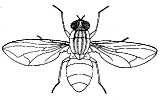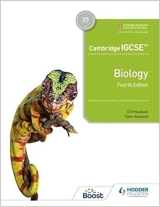The Housefly
For this reason, and, the fact that the housefly is an efficient and successful insect, it is important for the biologist to make a close study of its life history and habits.
Eggs.
The mature female housefly lays many batches of eggs with 100 to 150 eggs in each batch. Decaying organic matter such as manure heaps, faeces, or almost any exposed food material, are selected as breeding grounds.The last four segments of the abdomen of the female housefly, normally retracted and withdrawn into the body, are extended to make an ovipositor, by which means, the eggs are placed a few millimetres below the surface, and danger of drying out is avoided.
The eggs are white, elongate ovals, about one millimetre long and with two rib-like thickenings down each side. They hatch after eight to twenty-four hours according to the temperature. The bacteriological fermentation that goes on within a manure heap usually keeps the temperature high and fairly independent of external changes so that development proceeds rapidly.
Larva.
Emerging from the split egg-case, the larva is a semi-transparent maggot, later becoming white. Twelve segments are visible, becoming larger at the posterior end. The tiny head is usually pulled back into the anterior segments and is not visible. Two black, hook-like teeth projecting from above the mouth are used for movement through the breeding place and for tearing up potential food. The larva has no legs, but on the lower sides of segments six to twelve are crescent-shaped pads bearing short spines which assist its movement. Spiracles open on the second and last segments only.The larva feeds on the organic matter in which it finds itself, taking in only fluids and tiny particles. It has no simple or compound eyes but must be able to distinguish light and darkness since it moves away from light. This negative response to light tends to keep it in the warmer, moister regions of its breeding ground. It grows to about one cm long in five days, shedding its cuticle twice. Before its final ecdysis its reactions to light and moisture change, and it migrates to a drier position just below the surface of its breeding ground where it pupates.
Pupa.
The last larval cuticle is not cast but retained as a pupal case or puparium. The latter darkens and hardens, becoming a brown, cigar-shaped object. In the next three days the pupa metamorphoses to the perfect insect in a similar way to that described for the butterfly. A sac-like structure, the ptilinum, in the head, can be blown out by blood pressure and by this means the top of the puparium is burst open, after which the ptilinum is withdrawn into the head.Imago.
The imago crawls out of the puparium on to the surface of the breeding ground where its wings expand and harden in the next few hours, and then it flies away. In ten to fourteen days it may become sexually mature and lay eggs four days after mating. In suitable conditions of temperature, humidity and food, the entire life cycle may be complete in three or four weeks.Adult structures.
There are distinct divisions into head, thorax and abdomen. The houseflies, like the mosquitoes, are Diptera and have only one pair of wings, the second pair being reduced to halteres. The leading edges of the wings are thickened, and unlike the aphids which depend on chance air currents, house-flies are powerful fliers. Spiracles open on the first and third thoracic segments and on each of the abdominal segments. The three pairs of legs, like most of the rest of the body, are covered with sensory setae, and the last tarsus on each leg bears a pair of claws and two glandular pads which secrete a sticky substance enabling the fly to walk on smooth vertical surfaces.The pair of compound eyes on the head each have about 4000 facets, and there are three simple eyes or ocelli on the top of the head. Only the last segments of the short antennae are visible between the eyes.
Feeding.
The mouth parts comprise a proboscis, carried bent up under the head when not in use, but extended by means of blood pressure and muscles when feeding. The base of the proboscis is expanded into two lobes, the lower surface of which is traversed by parallel channels called pseudotracheae. Only liquids can be taken in by the housefly. When it settles on food the proboscis is extended so that the oral lobes are placed on the surface of the food. Saliva is secreted from salivary glands and runs down a channel into the pseudotracheae and on to the food which it begins to digest and liquefy. Muscles in the proboscis enable the oesophagus to pump up the semi-digested liquid from the pseudotracheae which converge into the oesophagus, and pass it to the crop and ‘stomach’ or mid-gut. Sometimes the fly regurgitates the partly digested fluid, which hangs as a large drop from the lobes of the proboscis and may be left on the surface where the fly has settled, and seen as a 'vomit spot’ on windows, etc. This procedure possibly enables the fly to mix more saliva with the food, since the salivary duct opens into the oesophagus only just above the lobes of the proboscis.The saliva probably contains a mixture of enzymes, since the fly can be seen feeding on a great variety of substances though it may have a preference for sweet and soluble carbohydrates.
Distribution.
Flies have been marked by putting a drop of paint on their abdomens when they emerge from their breeding ground. If later they are recaptured, some idea of their range of flight can be obtained. These experiments suggest that flies can normally travel up to 2 km from their breeding ground.Disease.
It is largely as a result of their indiscriminate feeding habits that houseflies spread disease. They may settle and feed on decaying organic matter which contains many bacteria. If later the flies alight on food for human consumption, harmful bacteria are deposited on it. There are many ways in which the bacteria may be carried. They may adhere to the hairs on the fly's legs or body; they may remain in the pseudotracheae or oesophagus, to be flushed out on to food with the next salivary flow. They may be deposited in vomit spots of semi-digested food which has come from a source of infection, or the bacteria may enter the digestive system and pass through it, unharmed, and fall on food with the faeces of the fly.Experiments in which flies have been allowed to walk over culture media in sterile dishes have resulted in the growth of over 100 bacterial and fungal colonies from bacteria and fungal spores which the fly deposited. Many of these bacteria are harmless to humans but others may cause serious disease. The greatest danger arises when flies are allowed to alight and feed on the faeces of a person suffering from intestinal disease such as typhoid, cholera or polio. Germs or spores of these diseases may thus be carried by the flies to human food. When this is eaten the bacteria can multiply inside the body and so infect the consumer with the disease. Flies are thought to be responsible for the spread of such diseases as those already mentioned above, also diarrhoea, anthrax, eye inflammation and possibly tuberculosis.
Control.
The principal methods of control are obvious once the ways in which flies can spread disease are known. Human faeces, particularly if known to be infected, must be disposed of in such a way that flies cannot possibly reach them. Other sources of infection such as manure heaps must not be allowed to accumulate for long periods near houses. Where this cannot be avoided the material should be stored in fly-proof containers.Food for human consumption must not be stored or displayed in such a way as to allow flies to settle on it. The numbers of houseflies should be kept as low as possible by removing decaying organic detritus in which they breed.
For illustrations to accompany this article see Insect Life-Cycles
| Search this site |
| Search the web |
© Copyright D G Mackean & Ian Mackean. All rights reserved.



